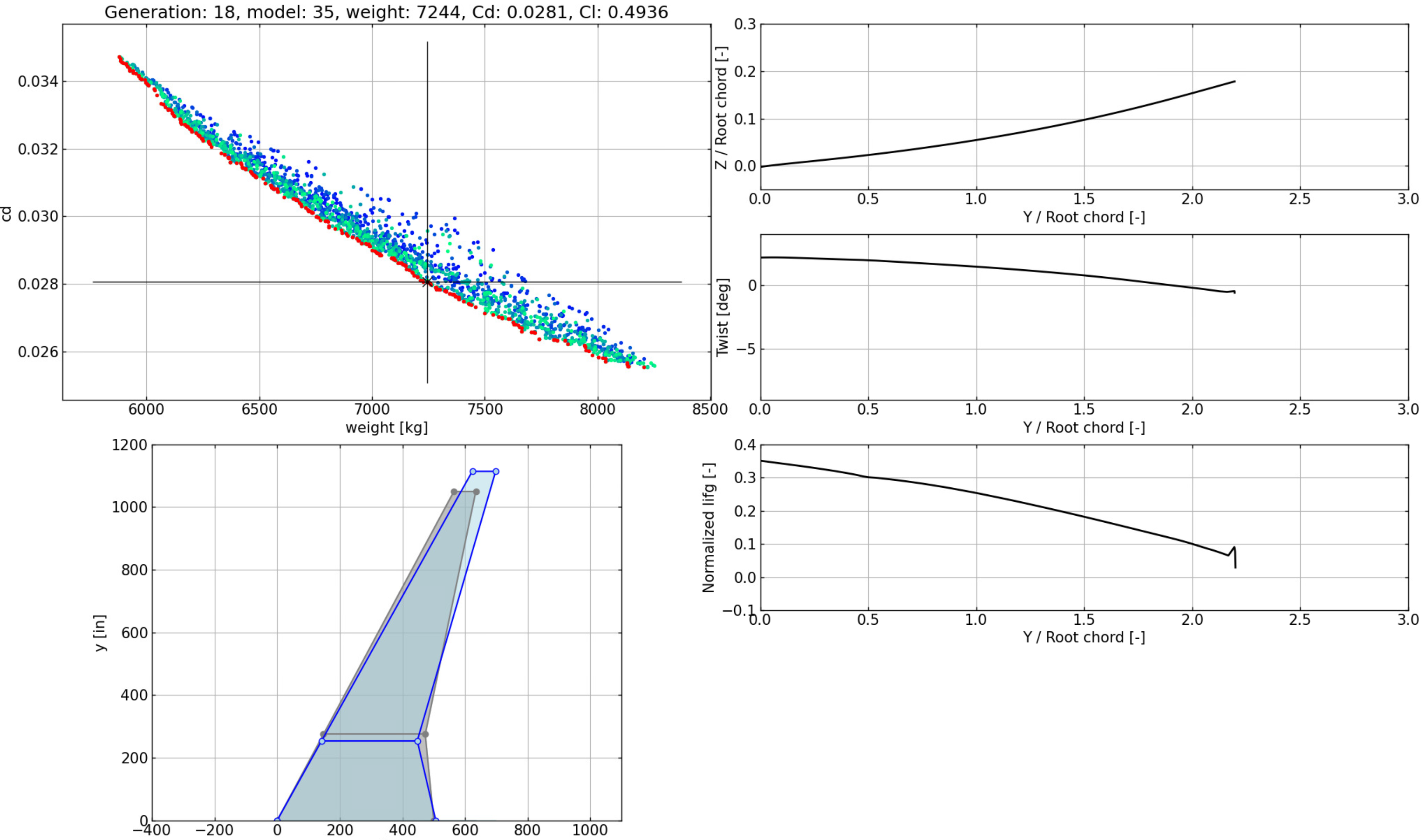Aeroelastic analysis
This is a tutorial for performing a two-way coupled fluid-structural analysis.
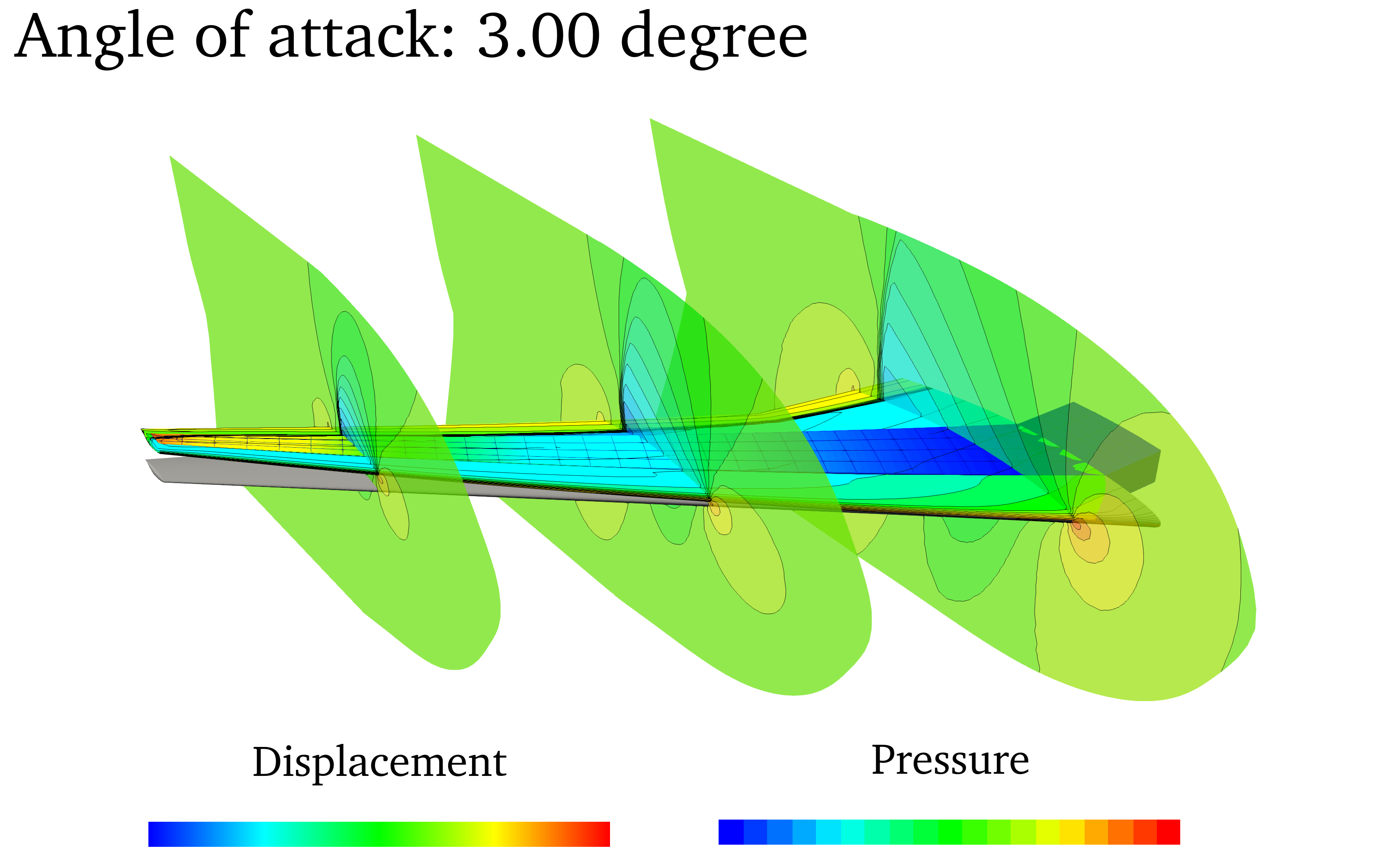

1. Set your environment
First of all, set work directory in “envs.sh”
#!/bin/bash set -eu Pwdir=$(readlink -f .) OrgDirPath=$(readlink -f .) WorkDirPath=${Pwdir}/"NAME_OF_WORK_DIRECTORY" ...
2. Set input files
Input files are set by default. If you want to change the analyisis condisions, model, solver, or algorithm, edit the following files.
Edit “system.sh” for a comprehensive setting of analysis conditions, e.g., solver, algorithm, number of iteration.
Data
File
Supplement
Analysis system
system.sh
Edit a list of files to change a wing model.
Data
File
Supplement
Wing geometry
Inp/Configs/winggeom.ini
Structural layout
Inp/Configs/stlayout.ini
CFD mesh info.
Inp/Configs/meshCFD.ini
CFD setting
Inp/Configs/CFD/
according to conditions
Material property
Inp/Configs/material.ini
Structural gauge
Inp/Gauge/gauge_minmax.csv
Inp/Gauge/gauge_init_shell.csv
Inp/Gauge/gauge_init_rod.csv
3. Execute analysis
Command is simple to carry out the analysis.
bash main.sh >& "log_file_name" &Depending on the setting and usage of MPI, the analysis will be terminated in 1-2 hours.
4. Post Process
You can see the results of analysis by opeing visualization files with your own hands. A list of visualizatino file is summerized below. The “File” in the list omits the path to your work directory (in “envs.sh”).
Data
File
Supplement
CFD surface mesh
01CreateFluidMesh/surface01.vtk
CSM model
02CreateStructMesh/wing_st.vtk
CFD results
04CalcFluidForce/CFD/work/results_cfd*.vts
04CalcFluidForce/CFD/work/results_cfd_surf.vts
CSM results
06CalcStructDisp/*G/result_FEM*.vtu
FEM results with *G laod factor
06CalcStructDisp/*G/result_FA.vtu
Failure modes and MS with *G laod factor
06CalcStructDisp/result_FEM*.vtu
FEM results at cruise condition
06CalcStructDisp/result_FA.vtu
summery of failure modes & MS
It is important to check results manually for validation and understanding the physics. However, the process requires a significant amount of time and hundreds of clicks. Therefore, we provide a series of plot programs to automatically generate plots of physical quantity.
Planform Optimization
This is a tutorial for planform optimization using two-way coupled fluid-structural analysis. NSGA2 is implemented as an optimizer, but another optimizer can be implemented at your own.
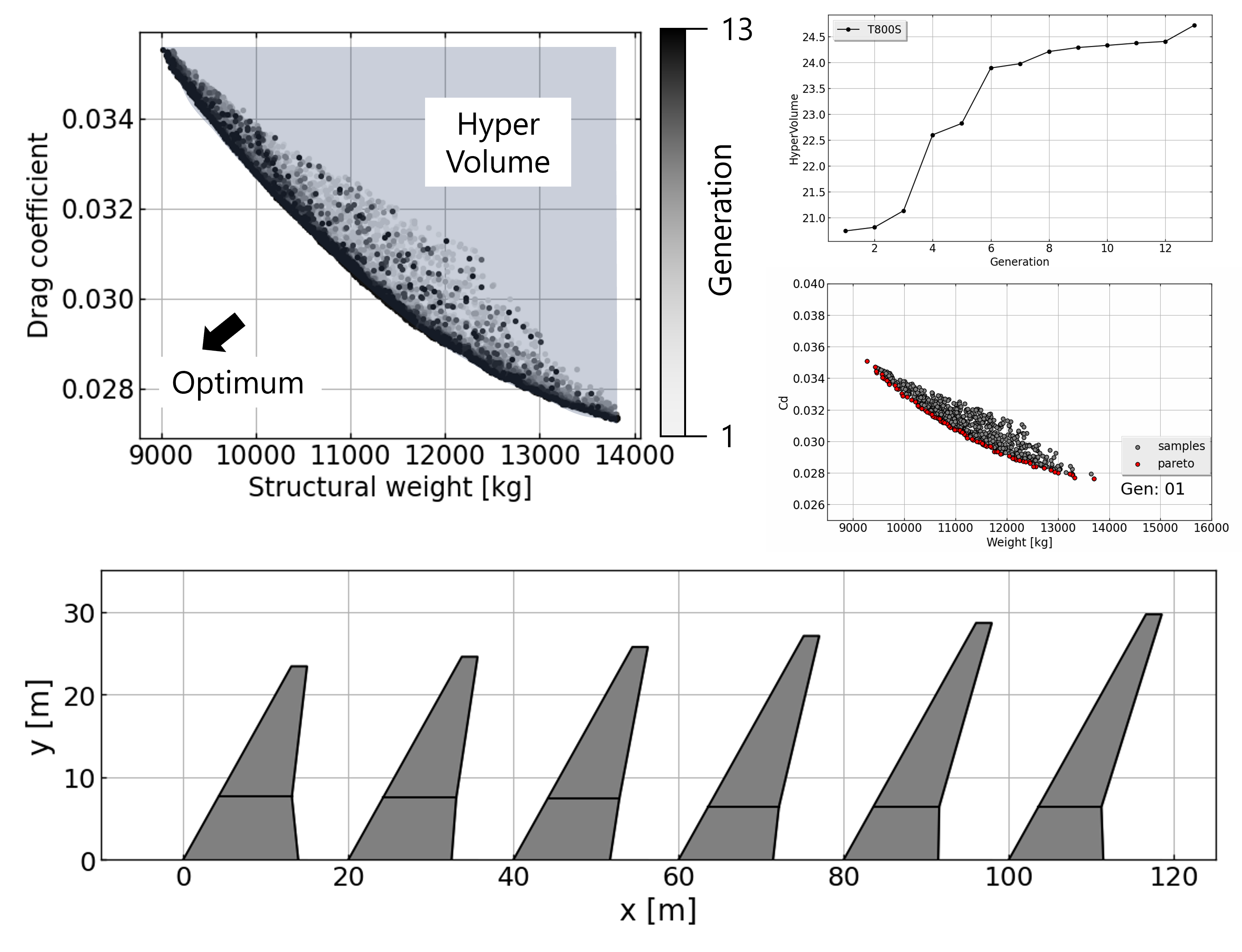
Objective functions (L), Hyper Volume (UR), Initial (BR), Planforms on pareto plane (B)
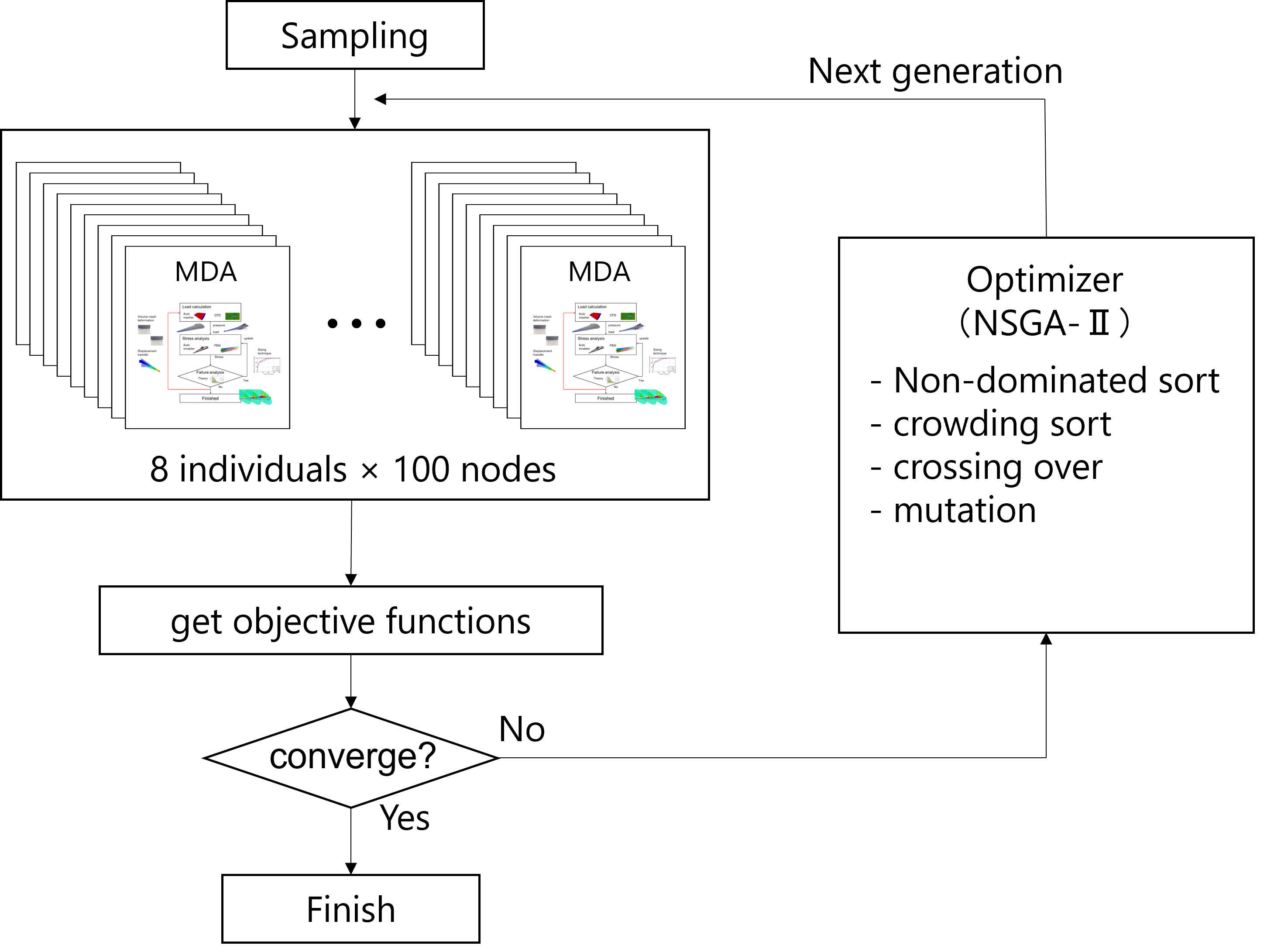
Procedure of planform optimization
1. Set your environment
Refer to 1. Set your environment
2. Set input files
Edit “system.sh” for model-wise parallelization. Check the number of parallelization and optimization flag.
In that case, CFD can not be parallelized because we do not use “MPI_Comm_spawn”. Thus, Edit “system.sh” as like this.
# MPI number NPMAX=8 # optimization problem OPT_PL='on' OPT_AF='off' ... MPI_CFD='off'Another settings for aeroelastic computation are available in 2. Set input files
3. Execute analysis
Command is simple to carry out the optimization.
bash exec_nsga2.sh >& "log_file_name" &
4. Post Process
After the optimization, work directory may look like this.
models*orgen*means generations of Genetic Algorithm.model*means individuals in a generation.Workdirectory/ ├── models0001 │ ├── model0001 │ ├── model0002 │ ├── model0003 │ ├── model0004 │ ├── model0005 │ ├── model0006 │ ├── model0007 │ ├── model0008 │ ├── model0009 │ ├── model0010 │ ├── model0011 │ ├── model0012 │ ├── model0013 │ ├── model0014 │ ├── model0015 │ ├── model0016 │ ├── objs_all.csv │ ├── objs.dat │ └── work_nsga2 ├── models0002 │ ├── model0001 │ ├── model0002 ...You can see the results of analysis for each individual by 4. Post Process
Ofcource, it is not necessary to check all the tens of thousands of different individuals on your own. The plot_programs in
Utilautomate it for you.
Example1: interactive plot for skimming.
Example2: plot objective functions
python Util/plot_programs/3Dplot_mat.py
Example3: plot correlation of design variables
python Util/plot_programs/plot_corr.py
Shape Optimization
This is a tutorial for shape optimization using two-way coupled fluid-structural analysis. In this document, shape optimization means (planform+airfoil) optimization. NSGA2 is implemented as an optimizer, but another optimizer can be implemented at your own.
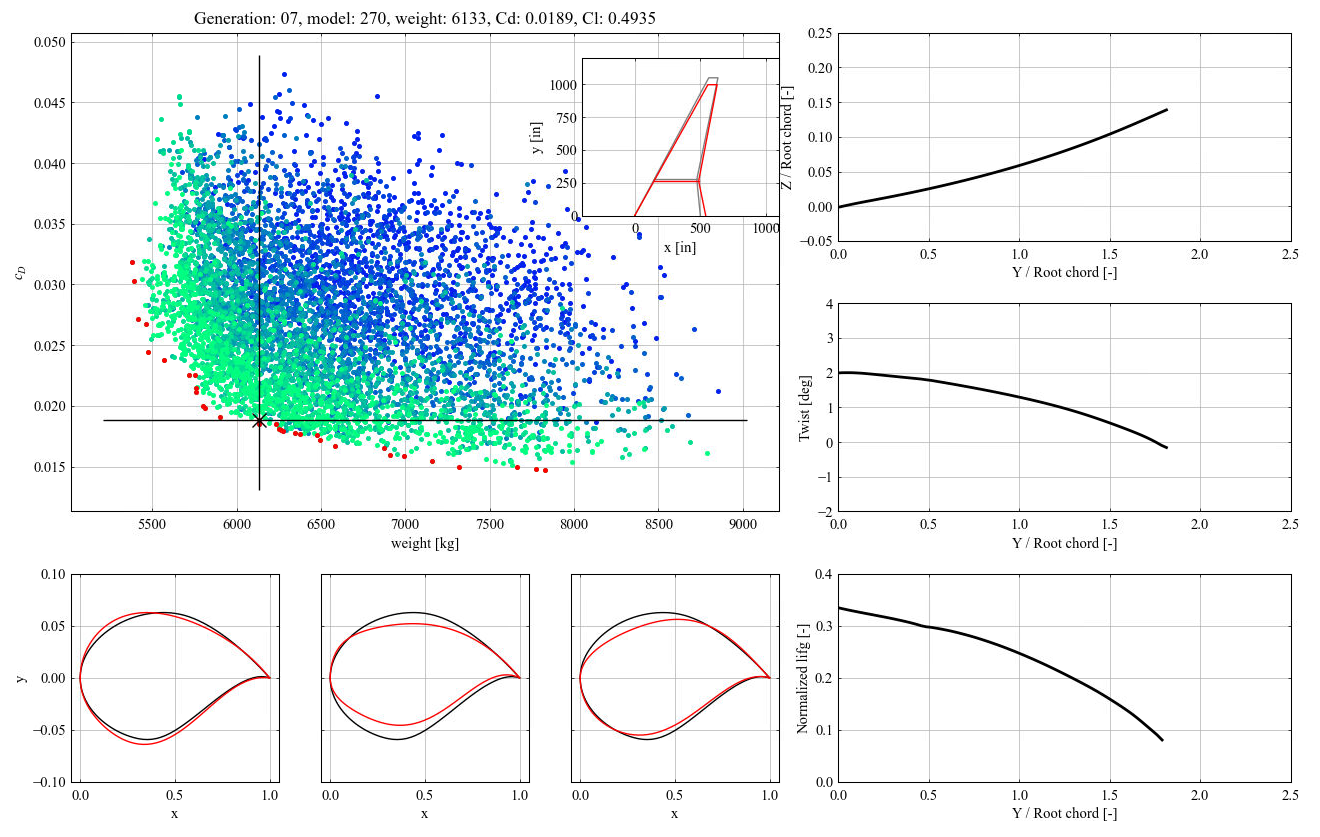
Objective functions (UL), Airfoils (BL), Deflection (UR), Twist (MR) Lift (BR)

Procedure of shape optimization
1. Set your environment
Refer to 1. Set your environment
2. Set input files
Edit “system.sh” for model-wise parallelization. Check the number of parallelization and optimization flag.
In that case, CFD can not be parallelized because we do not use “MPI_Comm_spawn”. Thus, Edit “system.sh” as like this.
# MPI number NPMAX=8 # optimization problem OPT_PL='on' OPT_AF='on' ... MPI_CFD='off'Another settings for aeroelastic computation are available in 2. Set input files
3. Execute analysis
Command is simple to carry out the optimization.
bash exec_nsga2.sh >& "log_file_name" &
4. Post Process
After the optimization, work directory may look like this.
models*orgen*means generations of Genetic Algorithm.model*means individuals in a generation.Workdirectory/ ├── models0001 │ ├── model0001 │ ├── model0002 │ ├── model0003 │ ├── model0004 │ ├── model0005 │ ├── model0006 │ ├── model0007 │ ├── model0008 │ ├── model0009 │ ├── model0010 │ ├── model0011 │ ├── model0012 │ ├── model0013 │ ├── model0014 │ ├── model0015 │ ├── model0016 │ ├── objs_all.csv │ ├── objs.dat │ └── work_nsga2 ├── models0002 │ ├── model0001 │ ├── model0002 ...You can see the results of analysis for each individual by 4. Post Process
Ofcource, it is not necessary to check all the tens of thousands of different individuals on your own. The plot_programs in
Utilautomate it for you.
Example1: interactive plot for skimming.
You can check individual differences by moving a mouse.
python Util/archives/iplot_objs.py "your_work_dir"
Example2: plot objective functions
python Util/plot_programs/3Dplot_mat.py
Example3: plot correlation of design variables
python Util/plot_programs/plot_corr.py
